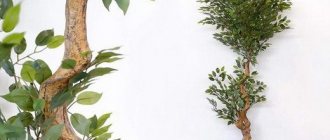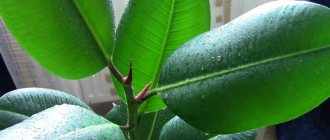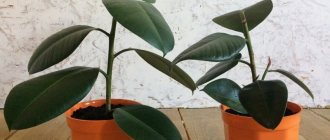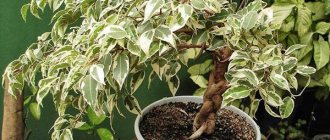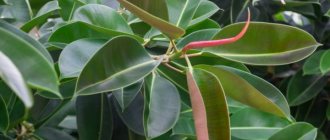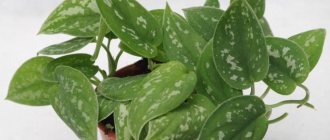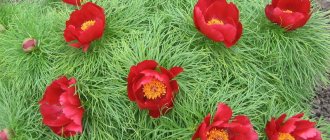Description of rubber ficus
The rubber ficus (Ficus elastica) is a true giant in nature. The height of the trunk reaches 30 meters. At home, the plant has a more modest size. Rich green oval foliage is covered with gloss. There is a noticeable point at the top. When young, the leaves are covered with a reddish stipule, which falls off when the plate unfolds.
Ficus flowering at home cannot be seen, since in an apartment it is impossible to create the same conditions for the development of culture as in the natural environment. Flowering can only be observed in greenhouses.
Botanical description of the plant
Painted outfit of rubber ficus
In its natural habitat, ficus grows as a tree, sometimes reaching a height of up to 30 m. Thanks to its aerial roots, it also grows in breadth. They descend to the ground and grow into the ground. Through aerial roots, the plant receives a set of necessary nutrients for good development.
The twisting roots of the ficus evoke an association among local residents with a snake. That’s what they call it: “Snake Tree.”
Leathery, elliptical, oval leaves are quite large, leathery, with a good gloss. They are located alternately on the tree.
Young foliage is hidden in stipules, colored red-brown. As the leaves unfold, they dry out and crumble.
In nature, pollination occurs thanks to a certain type of insect. But the process itself is of no value. When growing ficus indoors, there is no flowering, since there is no one to pollinate it, unless you do the cross-pollination yourself.
After flowering, small inedible syconia appear on the tree. The milky sap contained in ficus can cause allergic reactions.
Varieties of ficus rubber
There are many plant varieties:
- Variety Exotic. An unpretentious variety with rich green leaves, which are attached to the trunk by thin petioles. Can be grown in partial shade.
- Variety Danielle. Easy to care for, leaves are 6 cm long.
- Variety Monique. Light green foliage is shaded with gold. The leaves are small, reaching 6 cm in length. Brown stripes radiate from the central vein. With age, the variegation dissolves, the plates become monochromatic.
- Variety Reginald. A characteristic feature is the variegated color of the leaves. Young specimens have light green leaves. Ragged spots are scattered across the surface.
- Variety Kinkye. Bush-like form, formed by a large number of thin shoots. A cream stripe runs down the center of the green, elastic foliage.
- Variety Nicole. Characterized by moderate growth. Erect shoots are decorated with small leaves, 4 cm long. The leaf plates are concave along the central vein.
- Variety Stralight (Starlight). Picky about conditions of detention. If not properly cared for, the light leaves quickly fall off.
- Barok variety. A variegated variety with interesting, curled foliage. Easy to care for, but grows very slowly.
Sometimes you can buy ficus Elastica mix at a flower shop. The set includes plants of different varieties.
In nature and at home
The homeland of ficus is the tropical zone: Burma, Sri Lanka, Sumatra, the island of Java, the North-Eastern part of India. There they grow as lush trees up to 40 meters or more in height. Many species have dozens of fairly powerful aerial roots that fall to the ground for additional nutrition and respiration. In India, they are even used to create suspension bridges. In their native lands, all ficus trees bloom and bear fruit. The fruits of some are edible. Indoor ficuses bloom in the rarest of cases only if they are provided with all the conditions, and most importantly, given enough space. But you shouldn’t be upset about this, since the flowers (syconia) of most of them are inconspicuous pear-shaped formations with a hole, similar to figs. The fruits have approximately the same appearance.
In our apartments, ficus elastica does not grow huge and not all of them branch. This genus of plants has many species and varieties that differ significantly in appearance. Some bush, others do not. Some have green leaves, large or very small, others have variegated ones. Only the conditions of detention for all these varieties are approximately the same.
Growing ficus rubber
The main feature of ficus when grown at home is its unpretentiousness.
Lighting
Ficus Elastica is demanding of light, so it is advisable to place the pot with the plant next to a south window, but not on the windowsill, since direct rays of the sun will cause burns on the foliage.
Attention! When grown in partial shade, growth will be noticeably reduced. It is possible that the loss of the lower tier of foliage cannot be ruled out.
Temperature
In spring and summer, it is advisable to maintain the temperature in the room at +21-24°C. In winter, it is recommended to lower the temperature, but do not allow it to fall below +15°C.
What kind of pot do you need?
Ficus rubber does not like to grow in a spacious pot. The less space, the faster the flower grows.
What kind of soil/soil is needed?
Young plants are replanted annually. Older specimens do not require frequent transshipment, but the top layer of soil will need to be changed every year.
It is preferable to choose a substrate that is nutritious, well permeable to air and moisture. The earth is mixed with crushed coal and sand. The amount of baking powder is 1/5 of the total volume of the nutrient mixture.
Planting and transplanting
It is recommended to leave the newly purchased ficus in a shipping container for several days to adapt to the microclimate of the room.
Planting is carried out in several stages:
- for a flower up to 60 cm high, a container with a diameter of 10 cm is enough;
- the first layer is 2-3 cm of drainage (expanded clay, small pebbles, brick chips) for the unhindered outflow of excess moisture through special holes;
- the soil in the transport container is moistened;
- holding the stem, carefully remove the flower from the pot;
- the earth ball around the roots is lightly shaken off;
- a layer of pre-prepared soil is poured over the drainage;
- the flower is lowered into the pot without crushing the roots;
- the free space is filled with soil, lightly compacted and watered.
Attention! It is advisable to pour a layer of coarse river sand on top of the drainage.
Transplanting Belize into another pot follows the same sequence. After transshipment, the plant needs to adapt within a few days, then the soil can be fed.
What soil is suitable?
To ensure Belize Elastic normal growth and absence of diseases, the soil must be selected in accordance with the standards developed for this type of plant:
- slightly acidic or neutral (acidity level - 5.5-7 units);
- rich in micro and macroelements;
- loose, with good drainage.
Soil looseness is achieved by adding coarse, preferably river sand, expanded clay, and charcoal. Their use helps prevent stagnation of excess moisture, which causes the development of putrefactive processes in the root system.
You can buy a special soil mixture in the store, or you can do it yourself. For immature plants, soil consisting of equal parts of leaf humus, peat and sand is ideal. For adult ficuses, it is better to prepare a denser composition of 2 parts of leaf humus, 2 parts of turf soil and 1 part of sand. A mixture of leaf and turf soil, peat and sand in equal parts is also suitable.
Interesting! The interaction of expanded clay with liquid is similar to the absorbent qualities of a sponge; it also actively absorbs water along with nutrients. Then gradually returning them to the soil.
When is the best time to replant?
In order for the ficus roots to fully develop, it is recommended to replant the flower annually until it reaches 4 years of age. The pot is increased by 2-3 cm each time. Flowers older than 4 years do not need frequent replanting; it is enough to carry out the procedure once every 3-4 years. As plants age, they completely refuse to be replanted. To prevent soil depletion, change the top layer of soil 1-2 times a year.
Important! After transplantation, the tall plant is temporarily tied to a well-fixed vertical support (slat) until the root system is strengthened.
Caring for ficus rubber at home
Caring for a plant with glossy foliage involves providing timely watering, fertilizing, and spraying the foliage to increase humidity.
How often to water
Watering throughout the growing season should be moderate. In summer, the plant is watered at the root 2 times a week, in winter – once a week.
Spraying
Ficus rubber needs foliage spraying. To increase air humidity, you can place the pot with the plant on a tray filled with wet pebbles. In addition, the foliage should be wiped with a wet cloth.
Feeding and fertilizer
Starting in April, when the plant enters the active growth phase, the ficus is fed 2 times a month. Organic and mineral fertilizers are used. It is advisable to alternate them.
On a note! To make the leaves look glossy and reflect the surface, gardeners advise wiping the plates with non-alcoholic beer.
Trimming
Formative pruning will help curb the wild growth of ficus. In addition, the procedure will give the plant a compact appearance. Thanks to pruning, the number of shoots and foliage will increase, which is important, since with age the flower “goes bald”, that is, it loses its lower foliage.
Throughout the year, it is recommended to carry out sanitary pruning, in which thin shoots that are damaged and growing inward are removed.
Many gardeners practice removing the top. The maximum that such a procedure can lead to is the formation of another bud at the top. To get a good effect, it is recommended to remove up to 4 internodes.
Is it possible to leave without care while on vacation?
The answer is clear - no. Not a single plant can live without water. At a minimum, you need to find someone who will water the ficus during your absence.
Signs and superstitions
Among the Slavs, ficus has always been considered a creature of evil. The most negative events were associated with his presence in the house - illness, death, poverty. The most persistent belief among the people was that ficus awakens anger and envy in people, causing them to quarrel for no reason.
This plant was (and is) called “muzhegon”. There is an opinion that men do not stay long in a house where ficus grows. Therefore, it was contraindicated for unmarried girls to have it. And married couples in whose house this tree appeared were predicted to soon separate. It was also associated with a woman’s inability to give birth to a child. In general, they were blamed for all the troubles related to family and financial affairs.
In the West, ficus is revered as a plant that brings good luck and happiness. Feng Shui masters also attribute miraculous properties to it. The energy of wood, they say, helps strengthen family ties and improve the home atmosphere. In many countries, it is customary to give ficus to the closest and dearest people as a talisman and symbol of health and prosperity.
Reproduction of rubber ficus
Ficus elastica can be propagated by cuttings, layering and seeds.
Cuttings
The most convenient way with 100% results. You should choose a healthy cutting (stem or apical) and make a cut at an angle. The height of the cutting is at least 13-14 cm. All foliage will have to be removed, leaving only two plates at the very top.
The cutting is left at room temperature so that the milky juice stops flowing. You can root in water or directly in the ground. The last option is more effective. To make the ficus take root faster, it is recommended to create a mini-greenhouse over the cuttings.
Single-color varieties of ficus root without problems, varieties with variegated foliage are a little more difficult, so it is recommended to treat the cuttings with a root formation stimulator before planting.
By layering
Plants with painted foliage are easier to root by layering. To obtain layering, you will need to make a cut in the stem and insert a match into it. At the cut site, the stem is wrapped in sphagnum moss, and a film is rolled over it. As soon as roots appear on the cut, the cutting can be disconnected from the mother specimen and transplanted into a new pot.
Seeds
Small ficus seeds are laid out on the surface of moist, slightly compacted nutrient soil. To get seedlings, the seeds need to create comfortable conditions. To increase temperature and humidity, cover the container with seeds with film. The first shoots will appear after 1.5-2 months. Care consists of providing young plants with good lighting and regular watering.
Ficus with green leaves
The most popular among gardeners is Ficus elastica Robusta. In most cases, it has one straight stem that stretches right up to the ceiling. Its leaves are large, oval, up to 30 cm long and about 15 cm wide, rich green in color, smooth, glossy, very dense, with a curved tip. It is difficult to force it to grow as a bush. If you cut off the top of this ficus, several side buds begin to come to life, but, as a rule, only one grows, producing the same single stem. The remaining buds or their young shoots freeze. But Ficus Robusta among its fellows is considered the most patient and undemanding. You can force it to release side shoots not only by cutting off the top, but also by tilting the stem. Then the upper bud will begin to develop. When several leaves appear on it, the stem is straightened. Some gardeners make punctures on the stem with a needle (about 1/3 of the thickness). This stimulates bud growth.
Another popular type of plant is Ficus elastica - Abidjan. Outwardly, it is similar to Robusta, only its leaves are much darker, and their tip is pointed, but not curved. If you provide Abidjan with the right lighting, the color of the foliage becomes a dark beetroot color with red veins. This type of ficus is also quite unpretentious and undemanding.
Ficus elastica Melanie (pictured above) branches perfectly without human effort. Its leaves are smaller than those of the two previous species. They grow up to 15 cm in length and up to 7 cm in width. Their tip is curved. The plant looks very beautiful, as the leaves on the branches are arranged compactly. If you care for it correctly, you get a neat, lush bush. This species is a little capricious, loves regular spraying, requires fertilizing with nitrogen fertilizers, and does not tolerate drafts, rearrangements and dust on the leaves.
Diseases and pests
Among the harmful insects that plague the rubber ficus, scale insects and spider mites can settle on the shoots. If malicious pests are detected, the plant is treated with an infusion of tobacco and laundry soap. If it is possible to take the flower pot outside, treatment with acaricides is recommended.
When growing ficus, you may encounter some problems. If the ficus loses its foliage, the reason may be due to overdrying/overmoistening of the earthen clod, lack of lighting, or the presence of drafts.
The foliage turns yellow as a result of a lack of nutrients in the soil. To eradicate the problem, it is advisable to feed the plant with complex fertilizer.
Stunting is another problem that many gardeners face. There are three reasons:
- nutritional deficiencies;
- constraint of space;
- lack of natural light.
When errors in maintenance are corrected, the ficus actively begins to grow.
Choosing a location and lighting
Despite the light-loving nature, Ficus needs only diffused light . Direct sunlight causes burns on the leaves. It is possible to install the plant in the shade, but in this case its growth will be inhibited. In addition to inhibiting growth, the shadow provokes the fall of the lower tiers of leaves, which affects the decorative effect.
The presence of drafts or cold winds has a negative effect on plant growth. If it is necessary to ventilate the room, the plant should be moved to another place.
Photo of rubber ficus in the interior
Ficus Elastica fits perfectly into any interior. Beautiful glossy foliage looks decorative all year round.
Growing rubber ficus at home requires certain skills and sufficient space, as the flower grows up to 2 m in height. With proper formation, you can get a chic compact bush that will be the pride of the family.
Features and characteristics of ficus Belize Elastica
A distinctive feature of the flower is its reddish tint. On one leaf plate you can observe color transitions from bright green to rich burgundy.
Description of the variety Belize Elastica:
- The leaves are broadly oval, smooth, with entire edges, obtuse at the base and sharp at the apex.
- The location on the stem is the same. The leaf length reaches 23 cm, width - up to 13 cm.
- The venation is pinnate. The purple-red central vein, up to 8 mm thick at the petiole, is expressed on both sides of the leaf.
- The petioles are raspberry-colored, up to 5 mm in diameter and up to 2.5 cm long.
- Stipules of pink tones up to 18 cm in length.
- The stem is green with a cream tint with internodes of 2-3 cm. The smooth bark becomes coarser over time, and brown scars appear.
Interesting! External signs of Belize Elastic may vary slightly depending on the conditions of detention.
Trimming and pinching
Pruning should be done in the spring before active growth begins. The shoots are trimmed with a sharp blade, and the released plant juice is washed off with water. Ficus pruning is carried out so that the flower is of the required size. Pruning also encourages strong growth of new shoots, which will add some bushiness. How to prune ficus rubber plant correctly? It is best to trim to 5-6 internodes. You can trim the top of a long plant and then root it.
How to form a crown? The formation of the crown has a positive effect on the further growth of the flower. If your goal is to achieve lushness of the plant, then you can plant several specimens in one pot. If there is only one ficus in the pot, then its top needs to be tilted down and fixed. The growth bud, which will be tallest, begins to wake up and actively grow. After some time, the flower can be returned to its usual position.
How to pinch a flower? Pinching is pinching off the top of a plant using your fingers. The top shoots are very tender and break easily without pruning shears. Pinching is needed to enhance branching, because removing the top bud promotes the development of side shoots. Pinching is done before active growth begins, since only at this time the flower can quickly close the wounds.
Benefits and harms
Some Feng Shui experts claim that there are signs that ficus is capable of neutralizing bad energy in the house. Future parents who really want to have children, but are not yet able to do so, are advised to grow ficus trees in the bedroom.
The flower perfectly purifies the air and neutralizes poisons such as trichlorethylene and benzene, converting them into amino acids. Ficus also has many beneficial properties. Medicines made from the leaves and juice of the plant can cure mastopathy. Compresses help with joint diseases.
Contraindicated for asthmatics, because the rubber secreted by the plant is dangerous for them.
Website about the dacha
Ficus was brought from the impenetrable jungles of India. The first mention of it was written during the time of Alexander the Great, when during an Indian campaign his accompanying botanist made small notes about the vegetation of this area. This plant attracts flower growers with its beautiful glossy dark green leaves, and Ficus Benjamina - with the formation of trunks of any shape. It is not difficult to propagate, grow and care for an overseas plant; it is not demanding in care, but still needs warmth and the absence of drafts.
Feng Shui experts say that “Ficus is a tree of happiness that feeds on negative emotions.”
In warm countries with a subtropical climate, ficus grows to a majestic tree, reaching a height of 30-40 meters. It belongs to the Mulberry family of the order Rosaceae. Some species germinate in the bark of another tree species.
About ficus
An interesting fact is that ficus plants are epiphytes; when they fall on the branches and bark of other trees, they begin to sprout, forming aerial roots that grow very quickly, reaching the soil. Gradually they penetrate into the soil, and the roots begin to thicken, forming peculiar trunks. Banyan trees (growths from roots) take over large areas, overwhelming other plants and killing trees.
Ficus plants are moisture-loving plants; they naturally grow in humid, warm forests, so those who like to grow these plants should pay special attention to this fact.
correct distance between a wooden house and a brick garage
In our apartments, two types of ficus are most often found - Benjamina and rubber-bearing, and no more than 20 varieties are grown, although more than 1000 species are found in nature.
There are many legends associated with ficuses, but one of them, which people often use in their lives, says: “One sage helped a childless couple to conceive a child with the help of a ficus placed near the bed, they were ordered to tell all the emotions, feelings, events about the day of joy they had lived. and sadness"
Ficus rubber (elastic) - a lignified light or dark brown trunk with grooves along it, rough, young parts are bright green. The leaves are large, beautiful, tight, with a glossy surface on top and light green below with clearly defined veins. Young ones are colored red-brown. Their length is from 8 to 30 cm, width from 5 to 20 cm. In their homeland, trees grow up to 30-40 m in height, with a highly branched crown. At home, ficus plants rarely produce flowers and fruits. Its flowers are very beautiful, large, white with glossy petals, axillary, collected in inflorescences or solitary, forming a fruit - siconium.
One interesting historical episode is connected with the rubber ficus; it was considered a sign of luxurious life during the Soviet Union; seeing such a plant on the window or in the apartment of someone you knew, the owner almost turned into an enemy of the people.
Varieties of rubber ficus:
| Variety | Description |
| Baroque | A unique variety with curled small leaves, light green in color. |
| Starlight | The color of the wavy, small leaves is green-white, there may be several pure white or green on one tree, the rest will be painted with white-green stains. |
| Kinky | Very small leaves up to 2 cm, light green and milky white along the edge. |
| Curley | A whimsical, unusual variety, white spots may be unevenly distributed on its green leaves, unlike many marbled varieties. |
| Nina | Leaves up to 3 cm, light green with white splashes and a light yellow stripe along the edge of the leaf blade. |
| Nicole | A very similar variety to Nina, but the light yellow stripe is wider, sometimes it has a light yellow-green color. |
| Safari | Marble leaves, green and white, sometimes with splashes of white, look like computer squares. |
| Anastasia | The color is dark-light green, with the edges of the wavy leaves being lighter. |
| Golden King | The peculiarity of the variety is the change in color from variegated young leaves to the solid green of old ones, which grow up to 6 cm in length. The wave edge is lighter, interspersed with dark green color, while the main one is yellow-light green. |
| Exotic | A variety for creating incredible shapes from trunks that lend themselves well to bending and twisting when young. Leaf up to 5 cm, green. |
| Natasha | Low-growing variety, highly thickened crown, leaves up to 3 cm, light green. |
| Monique | Salad-colored leaves, corrugated, large 6-8 cm. |
| Viandi | The variety is similar to Natasha in leaves, but differs in the trunk, which bends strongly and becomes very fragile. |
| Daniella | For its species, the variety has large dark green leaves 5-6 cm long and 1.5-2 cm wide. |
| Fantasy | A variety with an interesting legend about the union of couples in love. The properties of a hybrid predominate; one stem or branch can be variegated, the other monochromatic. |
| Esther | Leaf up to 4-5 cm, light yellow-green color. |
Important! At home, latex, furniture, and suspension bridges are made from ficus.
Ficus benjamina is a small tree up to 10 m or a bush with a well-branched crown, small oval-pointed, glossy leaves. This wonderful species is unique in its kind; its stems can be braided in any shape. In apartment conditions, Ficus Benjamin does not grow more than 2-3 m. The stem is dark gray and rough.
Varieties of Ficus Benjamin:
| Variety | Description |
| Belize | The leaves are large, glossy up to 23 cm, with white-crimson streaks along the edges, and a clear burgundy vein in the center. |
| Tricolor | A variegated variety, a complex pattern, streaks across almost the entire leaf blade, marble-green and from milky white to creamy pinkish. |
| Robusta | Ellipse-shaped thick sheets up to 25 cm, the color is rich green, sometimes there are small inclusions of yellow or white. |
| Melanie | It differs from others in the density of alternate oval-shaped leaves; the variety is low-growing. The leaves are dark green, with a green-burgundy central vein. |
| Tineke | The leaves are large, up to 25 cm, variegated white-gray with a bright green edge and middle. |
| Sriveriana | Ellipse-shaped leaves up to 25 cm. Variety – chameleon. They are marbled in color, soft green with frequent splashes of white, gray, milky, and cream shades. But, if you grow it on the south side of the apartment on the window, the veining becomes burgundy, and the green takes on a darker color. If the plant is watered frequently, the constant moisture will cause it to lose its variegation. |
| Black Prince | The leaves are large, up to 30 cm, the plate is dark green on top and light green below, but when conditions change or the amount of lighting changes, it can change color to lighter tones. |
| Abidjan | Long, wide oval leaves with a pointed end, bright green color. This variety loves warm rooms with plenty of light. |
| Decor | A low-growing variety, with wide leaves up to 18 cm of rich green color, with clear veins. |
There are also varieties that are very similar to others in various characteristics, such as Mix (variegated), Eldorado, Naomi, Midnight Lady
Reproduction and cultivation of ficus
Ficus can be propagated in several vegetative ways:
Cuttings
It is better to take ficus cuttings in the spring during the active growing season, then the plant will form roots faster.
- On the ficus stem, select one branch, the size is not important, with several leaves, which is cut off with sharp pruners;
- make 2-3 oblique cuts on the branch from the cut to quickly form roots;
- coat the cut site with a root formation stimulator, phytohormone, and root;
- Pour warm water into a jar, lower the ficus branch, and place it in a well-lit place.
Important! A ficus petiole can form roots in 1 or 4-5 months, depending on the period (spring, winter) in which it was cut.
It happens when all the leaves fall off a plant, as a result of disease or improper care, then you can cut off the cuttings. Step back 5-10 cm from the top, select a place with 3-4 buds and step back 3-5 cm from them. This cutting is cut with a sharp, disinfected knife or pruning shears at an angle of 45 degrees. Place it in a jar with water and a root formation stimulator and cover it with a transparent bag on top, creating a greenhouse effect.
Video about ficus cuttings:
Propagation by leaves
Propagation by ficus leaves is a rather complicated process, especially if the leaf is cut without a stem fragment. Such rooting can and will happen, but it is not a fact that it will form new buds for further growth. Therefore, the leaf is cut off with part of the stem; the lower oblique cut can be located in the middle of the node, where there is a dormant bud above the leaf. For planting, it is best to use leaves from the main trunk, as well as from the side stem. To propagate in this way, you need to immediately immerse the leaf in a pot with prepared soil.
- The soil for ficus needs to be light, breathable, rich in minerals;
- You can prepare a soil mixture from soil from the garden, but steam it in the oven, add peat, turf, rotted manure or leaves (vermicompost);
- The acidity level should not be less than 6 and higher than 7;
- At the bottom of the pot there must be a layer of drainage with expanded clay, and put sand on top;
- Sprinkle the soil mixture on top and pour with warm water;
- Remove excess juice from the cuttings by holding under running water;
- Dry the cuttings, and loosely roll the leaf into a tube, tying it with an elastic thread;
- Then take a strong stick longer than the handle and insert it into the folded leaf. Next, stick the stick into the pot with soil, sprinkle it with soil 1.5-2 cm from the bud.
Important! When the leaves are cut, a poisonous white, viscous juice is released from them; do not allow it to come into contact with the skin, as this can cause allergies or burns.
Air outlets
The easiest way to propagate ficus is by air outlets; to do this, you will need to choose a place 5-10 cm away from the leaf. It is better for the formation of roots if the stem is green and not lignified.
- make 2-3 cuts and remove part of the bark;
- coat the open area with root;
- prepare a plastic bag and sphagnum moss (peat moss) or peat mixed with vermicompost;
- moisten the moss, wrap it around the cut area and wrap it in polyethylene to maintain moisture;
- When the moss begins to dry out, untie the bag from above and pour warm water over it.
The root forms after 1.5-2 months.
Basic rules for caring for ficus
Ficus is a moisture-loving plant; it should be watered regularly, but not flooded. Be sure to wait until the soil dries and loosen it. Depending on the room temperature and air humidity in the apartment, watering is carried out 2-3 times a week. In winter, watering is reduced to 1-2 times a week, as the plant goes into a dormant stage.
Spraying and wiping the leaves with warm water has a beneficial effect on the growth and development of the plant. These manipulations will help to effectively clean the leaves of excess dust, thereby increasing the effect of photosynthesis.
In autumn and spring, it is advisable to conduct fertilizing courses with the following preparations: Agricola, Master Valagro, Mister Tsvet, Aqua Terra, Rainbow, Pokon. Home remedies: sugar, iodine, tea leaves, coffee, succinic acid, vermicompost, rotted manure or chicken droppings.
Sources: https://dacha.ahuman.ru/trikolor-fikus/ https://ocvetah.life/komnatnye-rasteniya/geran/pelargoniya-davina.html
Feeding and fertilizers
To maintain active growth, fertilization is necessary. From April to October, fertilizing is applied every 2 weeks . It is recommended to alternate liquid organic fertilizers and mineral complex formulations. Fertilizers are applied after abundant watering to avoid injury to the roots by chemicals.
The recommended sequence of fertilizing is alternating Nitrophoska and mullein . It is unacceptable for fertilizers to come into contact with growth buds or leaves.
Main problems in care and cultivation
The main problem with Ficus is dropping leaves. Why Ficus leaves fall can be understood by observing it. The cause is usually improper care or pest attack. As a rule, Ficus sheds its foliage when the substrate is heavily flooded and it systematically does not have time to dry out. Insufficient watering or poor lighting can cause the leaves to fly away. Frequent drafts can also cause the stem to become exposed.
If the Ficus has just been brought home, then most likely the shedding of leaves is caused by the plant adapting to new living conditions. For some varieties this is even the norm.
Ficus is a plant that will make any room more comfortable. Even a beginner in floriculture can cope with its cultivation. The main thing is to devote a little of your time to it, and the ficus will delight its breeder with its chic decorative appearance for many years!
How do you like the article?

